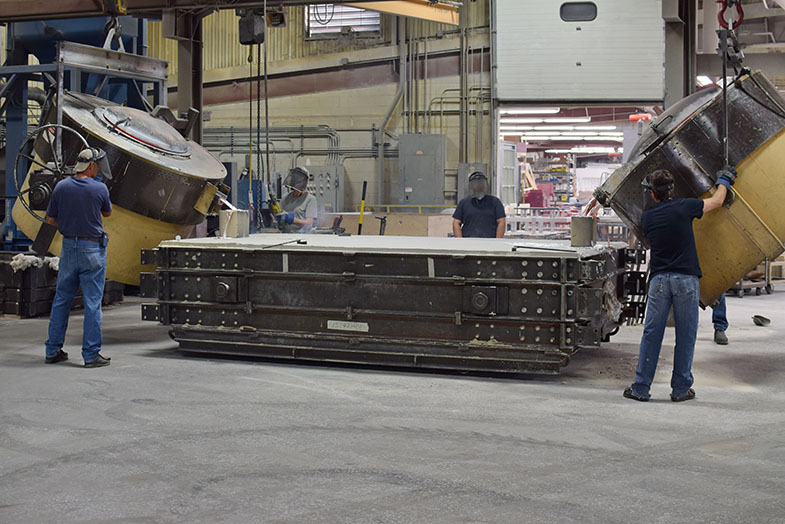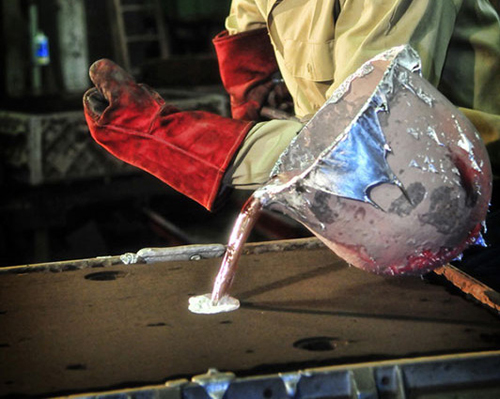Aluminum Foundry and renewable energy: Solar-powered casting
Wiki Article
Finding the Value of Aluminum Foundry in Sustainable Design Practices
Aluminum foundries are progressively acknowledged for their important function in sustainable design. By recycling light weight aluminum and using innovative modern technologies, they add to source preservation and decreased exhausts. This method promotes a circular economy, boosting product top quality while decreasing environmental effect. The trip towards sustainability in steel spreading is stuffed with difficulties and opportunities that call for more expedition. What exists ahead for light weight aluminum foundries in the pursuit for a greener future?The Duty of Aluminum Foundries in Source Conservation
Aluminum foundries play an essential role in resource preservation by successfully recycling aluminum materials. These centers are crucial in changing scrap light weight aluminum into top quality items, consequently reducing the demand for new light weight aluminum removal. The procedure includes thawing down used aluminum products, which calls for noticeably much less energy than producing aluminum from raw bauxite ore. By utilizing existing materials, foundries assist reduce greenhouse gas emissions related to mining and refining processes.In addition, aluminum foundries add to throw away decrease by drawing away scrap from land fills, promoting a more lasting strategy to source monitoring. They often team up with sectors to collect post-consumer and post-industrial aluminum waste, enhancing the total recycling framework. This method not just conserves all-natural sources but also supports the economic climate by creating work and cultivating technology in lasting engineering methods. Through these initiatives, aluminum foundries exemplify a dedication to environmental stewardship and resource efficiency in production.
Recycling and Repurposing: A Round Economic Climate Technique
The concept of a round economic climate is significantly getting traction in numerous sectors, consisting of light weight aluminum foundries. This method emphasizes the relevance of recycling and repurposing materials to minimize waste and maximize resource usage. In light weight aluminum foundries, reusing entails recovering scrap aluminum from production processes and end-of-life items, substantially decreasing the demand for virgin materials. This not just saves natural deposits yet also reduces power usage related to light weight aluminum production.Repurposing, on the various other hand, entails changing thrown out aluminum products into new, functional things, thereby extending their life process. By embracing these techniques, aluminum foundries add to a lasting production environment that prioritizes ecological obligation. The integration of recycling and repurposing within the aluminum sector lines up with broader sustainability goals, driving technology and boosting the economic practicality of round economy principles (Aluminum Foundry). Eventually, this method fosters strength within the industry while minimizing its ecological impact
Innovative Technologies Transforming Aluminum Spreading
Cutting-edge modern technologies are improving the aluminum spreading sector by presenting innovative molding strategies that improve accuracy and performance. Additionally, the growth of green alloys is promoting sustainability while maintaining performance standards. Automation in casting processes even more enhances manufacturing, minimizing waste and power consumption.Advanced Molding Techniques

Eco-Friendly Alloy Development
As the demand for lasting techniques in producing grows, the advancement of eco-friendly aluminum alloys has actually emerged as a critical focus within the light weight aluminum casting sector. These innovative alloys aim to lower ecological effect while maintaining exceptional efficiency characteristics. Researchers are discovering the consolidation of recycled products and safe components, which not only decrease the carbon impact yet also enhance resource effectiveness. Advanced approaches, such as the use of bio-based additives, are being examined to enhance alloy residential properties without jeopardizing sustainability. Furthermore, collaborations between academic community and market are fostering the development of alloys customized for certain applications, making sure that environment-friendly alternatives meet the strenuous demands of contemporary design. This dedication to sustainability settings the aluminum casting sector as a leader in liable manufacturing methods.Automation in Casting Procedures
While the aluminum casting market welcomes sustainability, automation in casting processes is concurrently revolutionizing production efficiency and high quality. Advanced innovations such as robotic arms, computer system numerical control (CNC) devices, and man-made intelligence are improving operations, reducing labor prices, and decreasing human mistake. These developments allow precise control over spreading criteria, guaranteeing constant item top quality and decreasing material waste. Furthermore, automated systems can monitor real-time data, permitting prompt adjustments to optimize efficiency. As a result, suppliers can improve their sustainability initiatives by enhancing resource usage and decreasing energy consumption. The combination of automation not just fulfills the expanding need for premium light weight aluminum components but also straightens with environmentally friendly methods, noting a significant advancement in the light weight aluminum foundry field.Reducing Carbon Footprints Via Sustainable Practices
A substantial decrease in carbon footprints can be accomplished with the implementation of sustainable methods in light weight aluminum foundries. By adopting energy-efficient technologies, foundries can decrease energy consumption, consequently reducing greenhouse gas discharges. In addition, the assimilation of recycled light weight aluminum considerably decreases the need for basic material extraction, which is resource-intensive and adds to environmental destruction.Implementing innovative melting strategies, such as induction melting, can likewise boost efficiency and lower emissions. Additionally, optimizing the spreading process via automation and surveillance can lessen waste and power usage.

The Impact of Aluminum Foundries on Different Industries
Aluminum foundries play a considerable duty throughout various sectors, supplying lightweight and long lasting products that enhance item efficiency and sustainability. In the auto sector, aluminum spreadings add to fuel efficiency by lowering vehicle weight, eventually causing reduced discharges. The aerospace industry benefits from light weight aluminum's strength-to-weight ratio, enabling the manufacturing of a lot more effective airplane layouts. In building and construction, light weight aluminum elements supply rust resistance and long life, making buildings a lot more lasting gradually. Furthermore, the electronics market makes use of aluminum for its excellent thermal conductivity, which is essential for heat dissipation in tools. In addition, aluminum foundries support the manufacturing of durable goods, offering aesthetically pleasing and useful items. As markets significantly prioritize sustainability, the role of light weight aluminum foundries becomes a lot more critical, making sure that materials not just meet performance criteria however additionally line up with ecological goals. Consequently, the impact of aluminum foundries extends throughout numerous fields, driving technology and advertising lasting practices.Challenges and Opportunities in Sustainable Metal Casting
As markets venture for sustainability, the challenges and possibilities in lasting metal casting come to be increasingly prominent. One significant obstacle is the ecological influence of typical casting processes, which commonly include high energy intake and exhausts. In addition, the need for competent labor in lasting practices postures problems for many foundries. However, chances are plentiful with advancements in innovation, such as the integration of energy-efficient strategies and the use of recycled products. Emphasizing the round economy, foundries can reduce waste and reduced prices while improving item top quality. Partnership amongst stakeholders, including suppliers and clients, can lead to innovative strategies that cultivate sustainability. Regulative stress encourage foundries to embrace greener methods, changing difficulties right into methods for development. By Aluminum Foundry addressing these obstacles, the metal casting sector can place itself as a leader in sustainable engineering, ultimately contributing to a more eco responsible future.Future Patterns in Aluminum Foundry Practices for Sustainability

Ingenious Recycling Methods
While the demand for lasting techniques continues to increase, innovative recycling methods are emerging as pivotal options within the aluminum shop field. Advanced approaches such as closed-loop recycling are gaining grip, allowing for the repurposing of scrap aluminum straight back right into the manufacturing process. This approach not just lessens waste but additionally reduces the carbon impact connected with light weight aluminum production. Furthermore, the growth of innovative sorting technologies enhances the efficiency of reusing operations, making sure premium feedstock for foundries. Techniques like hydrometallurgical recycling additional enhance source healing, enabling the removal of important materials from complicated aluminum alloys. As these developments progress, they substantially add to an extra lasting aluminum shop sector, lining up with worldwide environmental objectives.Energy-Efficient Casting Methods
Ingenious recycling strategies lead the way for improvements in energy-efficient casting techniques within the light weight aluminum factory industry. These techniques concentrate on reducing energy usage and decreasing waste throughout the spreading procedure. Strategies such as die casting and investment spreading are being fine-tuned to boost thermal performance and shorten cycle times. In addition, the integration of clever modern technologies and automation permits real-time surveillance and optimization of energy use. Researchers are likewise exploring alternative products and additives that can additionally improve energy efficiency (Aluminum Foundry). The change towards lasting methods is not simply governing; it reflects an expanding market need for greener items. As energy-efficient casting approaches develop, they assure to significantly lower the carbon impact of light weight aluminum production while keeping quality and efficiency standardsFrequently Asked Inquiries
What Are the Environmental Benefits of Aluminum Foundries Contrasted to Various Other Steels?
Aluminum foundries use considerable environmental advantages, consisting of lower energy intake, minimized greenhouse gas exhausts, and recyclability. Compared to other metals, light weight aluminum's lightweight nature improves gas effectiveness in transport, additional adding to sustainability in different markets.How Do Aluminum Foundries Add To Regional Economies and Task Development?
Aluminum foundries play a vital function in neighborhood economies by creating work possibilities and supporting supplementary markets. Their operations stimulate economic growth, improve labor force skills, and foster area growth via investment in neighborhood infrastructure and solutions.What Precaution Are Carried Out in Aluminum Foundry Procedures?
Safety and security actions in aluminum shop operations include individual safety equipment, air flow systems to minimize exposure to fumes, regular tools maintenance, safety training for employees, and stringent adherence to industry policies to decrease hazards and assurance worker safety.How Can Customers Support Sustainable Practices in Aluminum Manufacturing?
Consumers can support sustainable practices in aluminum production by choosing products made from recycled light weight aluminum, supporting for eco-friendly sourcing, and supporting business committed to lowering their carbon footprint and executing accountable manufacturing procedures.What Certifications Should Aluminum Foundries Seek for Sustainability Recognition?
Aluminum foundries must go after certifications such as ISO 14001 for ecological monitoring, LEED for environment-friendly building, and the Aluminum Stewardship Campaign standards to acquire acknowledgment for their dedication to sustainability and accountable production practices.Report this wiki page